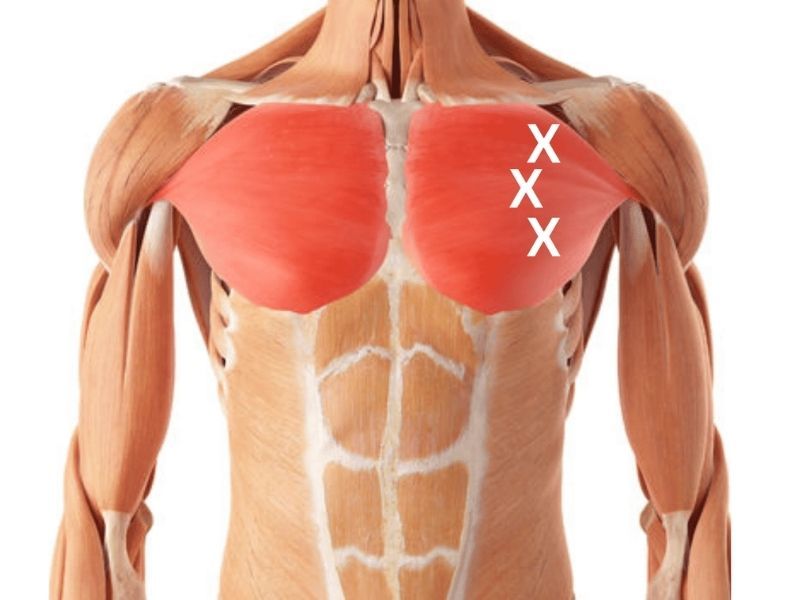Pectoralis Trigger Points | How To Find And Release

Table of Contents
Have you ever experienced chest or shoulder pain that seemed to defy explanation? It’s possible that pectoralis trigger points are the culprits. Unlocking pain relief by treating these trigger points can be life-changing. In this blog post, we’ll delve into the world of pectoralis trigger points, focusing on the major and minor muscles and their referred pain patterns.
Key Takeaways
- This article explores the characteristics and referred pain patterns of pectoralis trigger points, located in both the major and minor muscles.
- Common symptoms include mid-scapular back pain, breast sensitivity, chest pains mimicking cardiac angina, and shoulder/ulnar nerve discomfort.
- Treatments involve self massage techniques such as pressure application with fingers or a foam roller, professional therapy options like injections or neuromuscular therapy massage, stretching exercises to increase flexibility & strength. Plus prevention methods for future activation.
Understanding Pectoralis Trigger Points

Trigger points are localized, hyperirritable spots in a taut band of skeletal muscle, and they can cause pain both locally and in a referred pattern. The pectoralis major and minor muscles are particularly known for their trigger points, which can refer pain to the chest region.
We will delve into the specifics of these muscles and their referred pain patterns next.
Pectoralis Major Muscle
The pectoralis major muscle, also known as the pectoralis muscle, is a large fan-shaped muscle located in the chest that can develop trigger points, causing breast and nipple hypersensitivity. It is responsible for the movement and stabilization of the shoulder joint and comprises two heads: the clavicular and sternal heads. The clavicular head lies underneath the collarbone, while the sternal head is situated at the bottom of the sternum, just above the ribcage.
Muscle overload, poor posture, or injury to any of the three portions of muscle fibers that make up the pectoralis major muscle may activate trigger points. Damage to the nerve of the pectoralis major can lead to disruption in its normal functioning. This can result in denervation, atrophy or fibrosis of a section of the muscle. The symptoms associated with pectoralis trigger points may be more intense than the actual severity, giving the sensation of cardiac pain or even a heart attack.
Pectoralis Minor Muscle

The pectoralis minor muscle is a thin, triangular muscle situated at the upper part of the chest, beneath the pectoralis major muscle. It has the following features:
- Origin: 3rd to 5th ribs near their costal cartilages
- Insertion: Medial border and superior surface of the coracoid process of the scapula
- Primary actions: Stabilization, depression, abduction or protraction, internal rotation
- Function: Provides a passage for the vascular-nerve brachial system.
Referred Pain Patterns
Referred pain occurs when pain is felt in a different location than the actual source of the pain. In the case of pectoralis trigger points, pain referral may include:
- the chest
- anterior shoulder
- medial arm, which can cause arm pain
- inner elbow
These referred pain patterns can be confusingly similar to those of other conditions, such as cardiac pain or thoracic outlet syndrome, and can lead to misdiagnoses.
Before attributing chest pain to trigger points, verify there is no cardiac involvement.
Referred pain from pectoralis trigger points can also be associated with conditions such as mid-scapular back pain, breast pain, and pain radiating in the anterior shoulder and ulnar nerve path.
Understanding these referred patterns can help differentiate between pectoralis trigger points and other underlying conditions.
Identifying Pec Trigger Points
The pec major and minor muscles have unique trigger points that can be found using specific palpation techniques, which we will discuss in the following subsections.
Locating Pec Major Trigger Points
To identify trigger points in the pectoralis major muscle, begin by locating the sternal head of the muscle, situated at the bottom of the sternum, just above the ribcage. Use your fingers to trace up the muscle until you encounter a taut band, which may or may not produce a referral pattern to the shoulder or down the arm.
Locating Pec Minor Trigger Points
To find trigger points in the pectoralis minor muscle, start by identifying the clavicular head of the muscle, situated at the upper portion of the sternum, just under the collarbone. Again, move your fingers along the muscle until you detect a taut band, which may or may not produce a referral pattern to the shoulder or down the arm.
Potential Causes of Pectoral Trigger Points
Pectoralis trigger points can be activated or reactivated due to various factors such as:
- Muscle overload or fatigue
- Improper posture
- Stress
- Strenuous lifting
- Exposure to cold air from air conditioning
- Immobilization of the shoulder or arm in a cast or sling
- Excessive training volume in sports like weight training, rowing, boxing, and push-ups
Being aware of these potential causes can help you take preventive measures to avoid recurring pectoralis trigger point re-activation.
Treating Pectoralis Trigger Points
Effective treatment of trigger points (along with an overall integrative approach to pain) can provide significant pain relief and improve overall quality of life.
In the following sections, we will discuss self-massage techniques, professional therapy options, and stretching exercises that can help treat these trigger points.
Self-Massage Techniques
To release pec-based trigger points, you can employ various self-massage techniques such as applying static pressure to the sensitive points with your fingers, using a foam roller, or utilizing a massage ball.
When applying static pressure, hold a light to moderate pressure for 30-60 seconds and release, repeating as needed 1-2 more times. An important note that applying excessively aggressive pressure is NOT needed for results.
Always start with small amounts, and increase as tolerance improves over time.
Professional Therapy Options
Based on the provided text, I have split it into two paragraphs for improved readability:
For more targeted treatment of shoulder pain, particularly front shoulder pain, professional therapy options such as trigger point injections, neuromuscular massage therapy, and muscle energy technique stretching can be explored. Additionally, working with a trained therapist can help you learn effective stretching exercises to enhance shoulder range of motion and strength.
Stretching Exercises
Incorporating regular stretching exercises can help alleviate pectoralis trigger point pain and prevent reactivation. The Pec Major Stretch and Doorway Stretch are two recommended exercises for treating pectoralis trigger points. The Pec Major Stretch involves standing in a doorway, placing your arms on either side, and leaning forward until a stretch is felt in the chest.
The Doorway Stretch also requires standing in a doorway and placing your arms on either side of the doorway, then leaning forward until a stretch is felt in the chest area. Consistently performing these stretches can help to increase flexibility, reduce muscle tension, and alleviate pectoralis trigger point pain.
Preventing Pectoralis Trigger Point Activation
Preventing the activation of pectoralis trigger points can save you from unnecessary pain and discomfort. To avoid pectoralis trigger point activation, consider implementing the following techniques:
- Manual therapy
- Myofascial release
- Gentle stretching techniques
- Refraining from activities that put strain on the pectoralis muscles
Keeping a good posture and adding regular stretching exercises to your routine can also ward off the development of pectoralis trigger points.
Pectoralis Trigger Points and Related Conditions
Pectoralis trigger points are not only a source of pain in the chest and shoulder area but can also be associated with other conditions such as Thoracic Outlet Syndrome and Carpal Tunnel Syndrome.
Thoracic Outlet Syndrome is a condition caused by the compression of nerves and blood vessels in the thoracic outlet, resulting in pain, numbness, and tingling in the neck, shoulder, and arm.
Carpal Tunnel Syndrome is characterized by compression of the median nerve in the wrist, resulting in pain, numbness, and tingling in the hand and fingers.
Recognizing the association between pectoralis trigger points and these related conditions can help identify the correct diagnosis and appropriate treatment. Collaborating with healthcare professionals to address both pectoralis trigger points and underlying conditions can improve overall well-being and quality of life.
Summary
In conclusion, understanding and effectively treating pectoralis trigger points can provide significant pain relief and improve overall quality of life.
By learning about the pectoralis major and minor muscles, identifying their trigger points, and employing self-massage techniques, professional therapy options, and stretching exercises, you can unlock pain relief and prevent the reactivation of these trigger points.
Remember to consult with a healthcare professional before initiating any treatment plan to ensure the most appropriate and effective approach for your specific needs.
Sam Visnic
I’ve spent my life studying the fundamental aspects of human health with a focus on movement and clinical massage therapy. In a world of specialists, surgical procedures, drugs and quick fix remedies, I’m committed to finding and developing strategies that help people stuck at the “gap”. Over the last 20 years I’ve studied dozens of systems and methodologies for uncovering the root cause of aches and pains, along with postural and movement issues. Pain science, the art and science of hands-on soft tissue massage techniques, myofascial release, and coaching movement is essential in my practice. Integrating different methods but above all deciphering WHEN to use different techniques with different people and situations, along with integration of movements that people want to be able to do again is the key to long term success with my incredible track record with clients. Understanding the various elements that contribute to conditions and the power of communication and education makes my Release Muscle Therapy program separate from other hands-on therapy approaches.
Blogs You May Be Interested In
Categories
-
Deep Gluteal Pain Syndrome
-
Deltoids
-
Fallbrook
-
Foam Rolling
-
Glutes
-
Hamstrings
-
Hypnosis For Pain
-
Lats
-
Levator Scapulae
-
Lifestyle
-
Massage Therapy
-
Mobility
-
Movement and Exercise
-
Murrieta
-
Muscles
-
Nutrition
-
Obliques
-
Pain
-
Pectorals
-
Piriformis
-
Plantar Fasciitis
-
Product Review
-
Psoas
-
Quadratus Lumborum
-
Quadriceps
-
Rhomboids
-
Serratus Anterior
-
SI Joint
-
Sternocleidomastoid
-
Stretching
-
Subscapularis
-
Temecula
-
TMJ
-
Trapezius
-
Uncategorized















